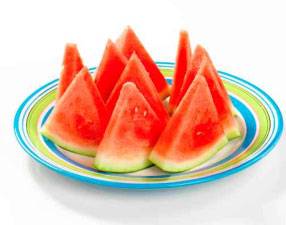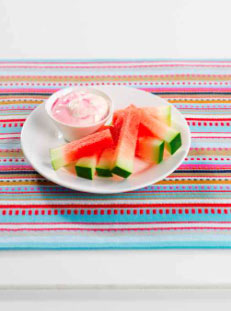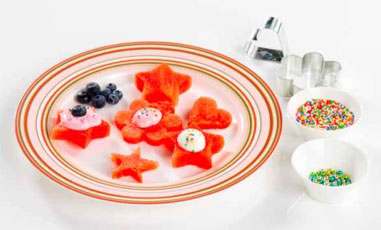Seedless Watermelon changing habits

Form healthy habits for your family in 2009 with Seedless Watermelon!
With the chaos of Christmas way behind us and the cooler months already being felt, there's no better time to form healthy habits for you and your family such as encouraging your children to get their required daily intake of fruit and vegetables.
Worryingly, a recent study conducted by the federal government found that almost one quarter of Australian children are overweight or obese, and that only one per cent of 14 to 16 year olds eat enough fruit. The 2007 Australian National Children's Nutrition and Physical Activity Report*, compiled from the results of the survey conducted of 4487 randomly selected children from across the nation, highlighted how fruit, vegetables and dairy foods are being replaced by foods high in kilojoules, salt and saturated fat - putting children at risk of developing type two diabetes, high blood pressure and heart disease.
Served in wedges or slices as a snack, or dipped in yoghurt as a sweet treat, Seedless Watermelon is a great tasting fruit that is nutritious for children too. A fantastic food to encourage children to up their daily intake of fruit, Seedless Watermelon is available 52 weeks of the year, and is also a natural thirst quencher - made up of 92% water and only 8% sugar. A cup of chopped Seedless Watermelon (160g) contains only 54 calories (230 kilojoules), 0g fat, 10g of natural sugars and provides more than the daily recommended amount of vitamin C**
A positive finding from the report highlighted how more than half of children aged four to eight years old eat enough fruit. Forming healthy habits from a young age can assist children in making good food choices later in life - and sweet tasting, easy to eat Seedless Watermelon is perfect to get kids off to the right start when snacking.
Assist your children to form healthy eating habits and up their intake of fruit in 2009, by trying out some of the fun recipes and serving suggestions below - and remember you can lead by example and enjoy the great taste of Seedless Watermelon too!

200g low fat vanilla flavoured yoghurt
One teaspoon of honey (optional)
Seedless watermelon cut into sticks
METHOD
1/ Get an adult to help cut up the Seedless Watermelon into dipping sticks.
2/ To make the dip, stir the yoghurt and honey together in a small bowl until combined. To serve, spoon the dip into a bowl and place on a plate, alongside the seedless watermelon sticks.

Seedless Watermelon cut into p- to -inch thick slices
Natural Yoghurt
Coloured sprinkles, raspberries and blueberries
METHOD
1/ Get an adult to help you cut the watermelon into thick slices.
2/ Using your favourite cookie cutters, cut out shapes from the watermelon slices.
3/ Once you've cut out your shape, use the yoghurt as the icing. You can either cover the entire surface or use a toothpick dipped in the yogurt to decorate, for e.g. petals on a flower shape or eyes on an animal shape.
4/ Use coloured sprinkles and cake decorations to finish off your creation.
INGREDIENTS
p large wedge Seedless Watermelon cut into large pieces
p cup raspberries
1 cup (250ml) water
? cup caster sugar
p cup (125ml) lemon juice
METHOD
1/ Place Seedless Watermelon, raspberries and water in container of electric blender, cover and blend until smooth.
2/ Stir in sugar and lemon juice until sugar dissolves.
3/ Pour into ice block moulds, insert popsicle sticks and freeze overnight.
4/ Serve as a hydrating snack after school, or on a sunny weekend with friends!
Brought to you by The Harvest Company - we're changing the way Australians eat
Visit www.seedless.com.au for more interesting facts and great recipes forSeedless Watermelon!
*2007 Australian National Children's Nutrition and Physical Activity Survey. Main Findings. Prepared by the Commonwealth Scientific Industrial Research Organisation (CSIRO), Preventative Health National Research Flagship and the University of South Australia.
**Based on the RDI for vitamin C for children aged 4-8 years. Nutrient reference values for Australia and New Zealand, Executive Summary. National Health and Medical Research Council, 2005.
With the chaos of Christmas way behind us and the cooler months already being felt, there's no better time to form healthy habits for you and your family such as encouraging your children to get their required daily intake of fruit and vegetables.
Worryingly, a recent study conducted by the federal government found that almost one quarter of Australian children are overweight or obese, and that only one per cent of 14 to 16 year olds eat enough fruit. The 2007 Australian National Children's Nutrition and Physical Activity Report*, compiled from the results of the survey conducted of 4487 randomly selected children from across the nation, highlighted how fruit, vegetables and dairy foods are being replaced by foods high in kilojoules, salt and saturated fat - putting children at risk of developing type two diabetes, high blood pressure and heart disease.
Served in wedges or slices as a snack, or dipped in yoghurt as a sweet treat, Seedless Watermelon is a great tasting fruit that is nutritious for children too. A fantastic food to encourage children to up their daily intake of fruit, Seedless Watermelon is available 52 weeks of the year, and is also a natural thirst quencher - made up of 92% water and only 8% sugar. A cup of chopped Seedless Watermelon (160g) contains only 54 calories (230 kilojoules), 0g fat, 10g of natural sugars and provides more than the daily recommended amount of vitamin C**
A positive finding from the report highlighted how more than half of children aged four to eight years old eat enough fruit. Forming healthy habits from a young age can assist children in making good food choices later in life - and sweet tasting, easy to eat Seedless Watermelon is perfect to get kids off to the right start when snacking.
Assist your children to form healthy eating habits and up their intake of fruit in 2009, by trying out some of the fun recipes and serving suggestions below - and remember you can lead by example and enjoy the great taste of Seedless Watermelon too!

Seedless Watermelon Strawberry Dippers!
INGREDIENTS200g low fat vanilla flavoured yoghurt
One teaspoon of honey (optional)
Seedless watermelon cut into sticks
METHOD
1/ Get an adult to help cut up the Seedless Watermelon into dipping sticks.
2/ To make the dip, stir the yoghurt and honey together in a small bowl until combined. To serve, spoon the dip into a bowl and place on a plate, alongside the seedless watermelon sticks.

Seedless Watermelon Shapes!
INGREDIENTSSeedless Watermelon cut into p- to -inch thick slices
Natural Yoghurt
Coloured sprinkles, raspberries and blueberries
METHOD
1/ Get an adult to help you cut the watermelon into thick slices.
2/ Using your favourite cookie cutters, cut out shapes from the watermelon slices.
3/ Once you've cut out your shape, use the yoghurt as the icing. You can either cover the entire surface or use a toothpick dipped in the yogurt to decorate, for e.g. petals on a flower shape or eyes on an animal shape.
4/ Use coloured sprinkles and cake decorations to finish off your creation.
Seedless Watermelon and Raspberry Icy-poles!
Serving size: Makes 8 x 100ml ice blocksINGREDIENTS
p large wedge Seedless Watermelon cut into large pieces
p cup raspberries
1 cup (250ml) water
? cup caster sugar
p cup (125ml) lemon juice
METHOD
1/ Place Seedless Watermelon, raspberries and water in container of electric blender, cover and blend until smooth.
2/ Stir in sugar and lemon juice until sugar dissolves.
3/ Pour into ice block moulds, insert popsicle sticks and freeze overnight.
4/ Serve as a hydrating snack after school, or on a sunny weekend with friends!
Brought to you by The Harvest Company - we're changing the way Australians eat
Visit www.seedless.com.au for more interesting facts and great recipes forSeedless Watermelon!
*2007 Australian National Children's Nutrition and Physical Activity Survey. Main Findings. Prepared by the Commonwealth Scientific Industrial Research Organisation (CSIRO), Preventative Health National Research Flagship and the University of South Australia.
**Based on the RDI for vitamin C for children aged 4-8 years. Nutrient reference values for Australia and New Zealand, Executive Summary. National Health and Medical Research Council, 2005.
MORE





